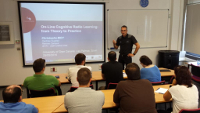Seminario día 25 de mayo de 2016
|
Titulo: On-Line Cognitive Radio Learning: from Theory to Practice
Impartido por: Christophe Moy. Supelec, Universidad de Rennes (Francia)
|
|
Presentación en PDF

|
Short CV:
Christophe MOY received the engineer diploma of the INSA (National Institute of Applied Sciences), Rennes, France, in 1995. He received his M.Sc. and Ph.D. degrees in Electronics in 1995 and 1999 from the INSA, and his HDR (Habilitation a Diriger des Recherches) from University of Rennes1 in 2008. Since 2005, he has been a Professor at CentraleSupelec (created in January 2015), formerly Supelec. He worked before in Mitsubishi Electric European Research Lab on digital communications from 1999 to 2005. He is also now the co-head of Communications Department of the CNRS lab IETR (Institute of Electronics and Telecommunications of Rennes - UMR 6164). His research targets radio communications systems and digital electronics design for flexible, autonomous and highly intensive computing systems, to sum-up software radio and cognitive radio. He was involved in many European and French collaborative projects. He has written more than 20 book chapters, 25 journal papers and 100 conference papers on software and cognitive radio.
|
Abstract:
Cognitive radio (CR) aims at studying how future radio devices (terminals, radio access points, communicating objects) and systems (mobile networks, WLAN, Internet of Things, etc.) will benefit from self-awareness means in order to adapt in real-time to radio environment in the large sense (propagation of course, but also other radio users and networks in the area). In the spectrum domain, CR is especially foreseen as a solution to spectrum scarcity issue.
|
|

|
| Moreover, beyond pure radio communications domain, these features will also contribute to the expansion of other systems that will integrate new smart capabilities thanks to wireless communications, such as Smart Grids, Smart Cities, Smart Home, Intelligent Transport Systems, etc. This presentation first illustrates that cognitive radio implementation relies on 3 mains following features to be integrated in equipments: software radio, sensing, learning and decision making. Then a focus is made on on-line learning. The context of Opportunisitic Spectrum Access (OSA) is a future solution to better use spectrum resources. We see how this problem can be modeled as a classic machine learning model (Multi-Armed Bandit - MAB) and how re-inforcement learning algorithms such as UCB (Upper Confidence Bound) can address OSA issue. Theoretical results have been obtained, validating step by step the following issues: proof of converge, effect of sensing errors, convergence speed. Then real experiments done in lab conditions, validate the theoretical assertion on both i.i.d. and Markovian channel occupancy models for primary users. Confrontation to real radio patterns in HF domain shows that the approach still remains valid outside strict hypothesis of the theoretical models. |





